

| 
|

The solar corona as seen during the total solar eclipse of August 21, 2017. The new moon is visible covering the Sun in this deep exposure. The Moon is illuminated by "earthshine," light reflected off of the Earth onto the dark side of the Moon. The bright star on the left edge of the image is Regulus, the "heart of the lion" in the constellation Leo. Details from the center of this image are shown below, along with other images.
Composite of 28 frames with exposure ranging from 1/2000 second to 4 seconds at ASA 100 through an equatorially mounted Astro-Physics 105mm refractor with field flattener at f6.2 using a Canon 5DIII from Silver Point, Tennessee. All frames were corrected using an additional 225 flat field, dark, and bias frames. Coronal details were enhanced using HDR and radial-blur techniques. ©2017
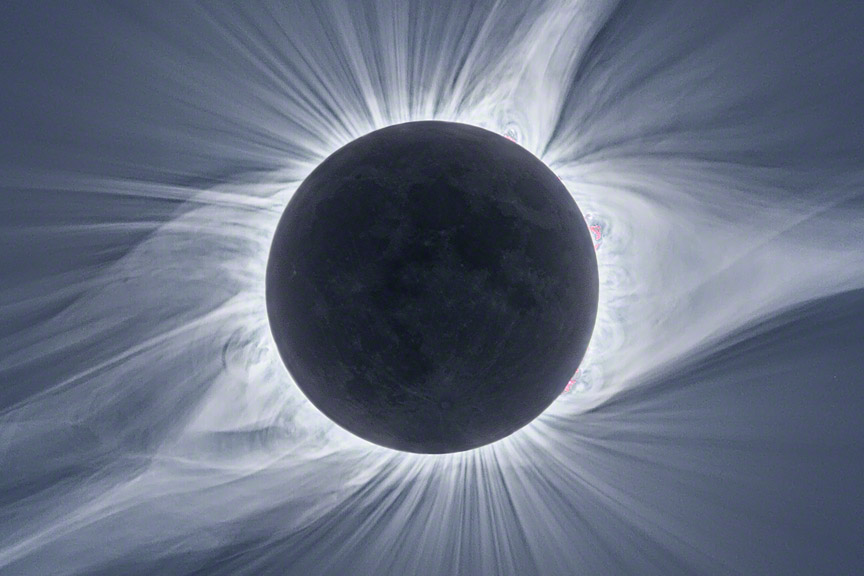
Detail from the above image. Coronal loops can be seen following magnetic field lines that emerge from the Sun. Craters and maria on the new moon look similar to what can be seen during a full moon. Pink solar prominences are visible on the right. Details of the prominences are shown below.
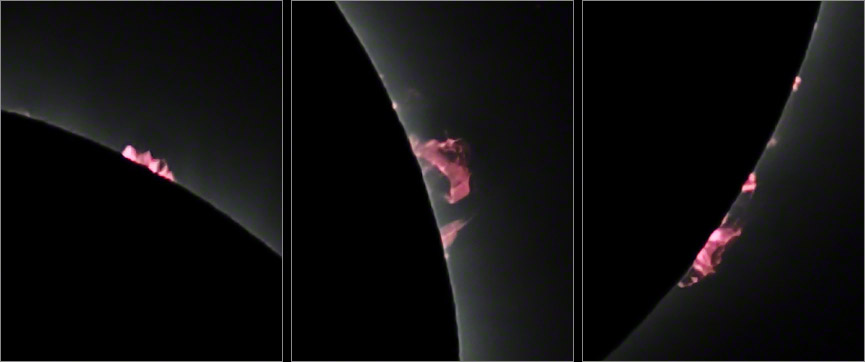
Solar prominences visible on the right side of the Sun during totality. Prominences are dense plasma thrown into space from the surface of the Sun. The Earth would easily fit under the arc of the large prominence in the center frame. (These images are from very short exposures chosen to capture the prominences. Longer exposures were used to capture the corona as shown above.)
Details from a composite of two frames, 1/2000 seconds and 1/1000 seconds, at ASA 100 through an Astro-Physics 105mm refractor with field flattener at f6.2 using a Canon 5DIII from Silver Point, Tennessee. ©2017
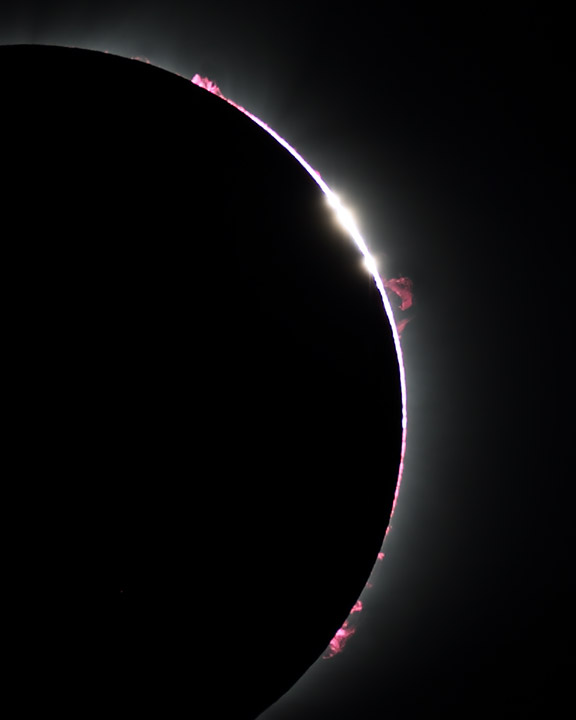
Solar prominences and Baily's Beads visible on the right side of the Sun at the end of totality. (Details of the prominences are shown above.) As the surface of the Sun first becomes visible through valleys on the limb of the Moon, dazzlingly bright beads appear on the edge of the Moon. They grow to form the "diamond ring," shown below, and then merge to form the crescent Sun of the partial phases, also shown below.
A composite of two frames, 1/2000 seconds and 1/1000 seconds, at ASA 100 through an Astro-Physics 105mm refractor with field flattener at f6.2 using a Canon 5DIII from Silver Point, Tennessee. ©2017
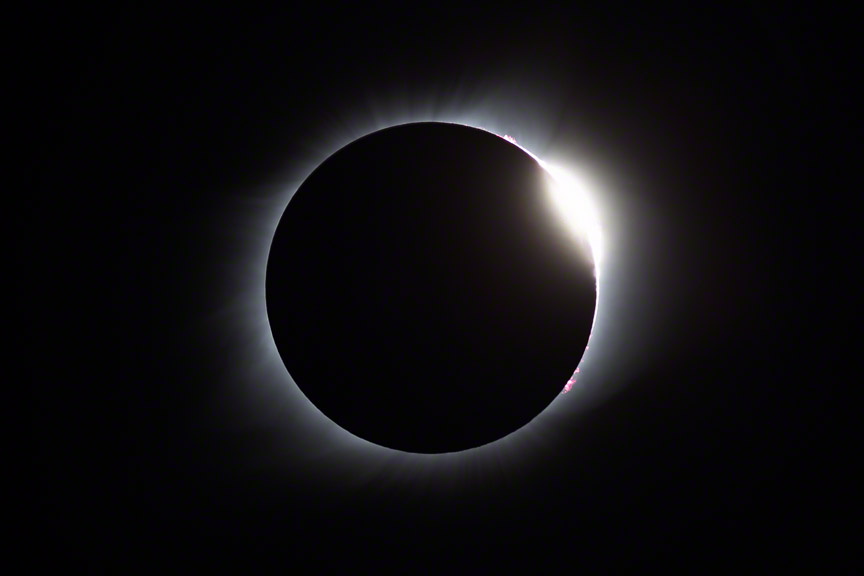
The "Diamond Ring" is caused by the surface of the Sun glaring through mountain valleys on the limb of the Moon as totality ends.
1/250 second exposure blended with an HDR composite of six exposures ranging from 1/2000 second to 1/60 second at ASA 100 through an Astro-Physics 105mm refractor at f6.2 using a Canon 5DIII from Silver Point, Tennessee. ©2017
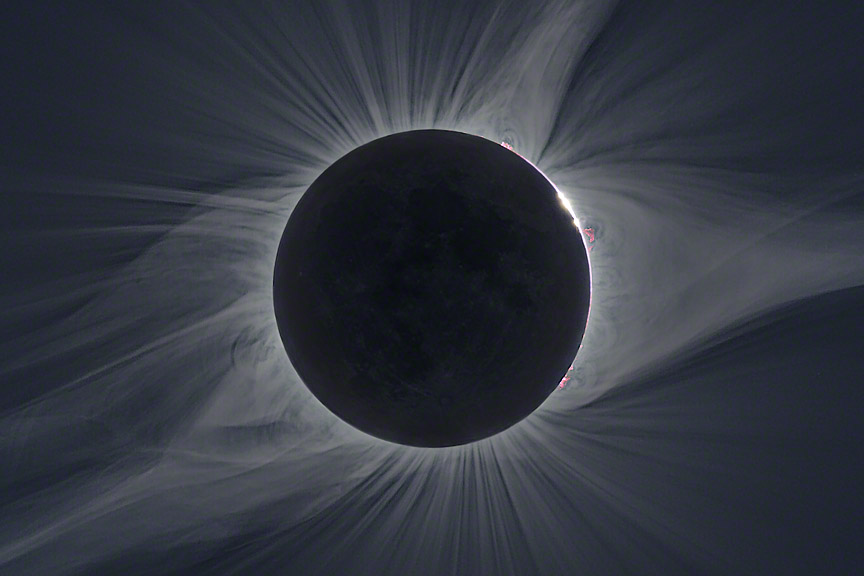
The end of the totality, showing the corona as Baily's Beads first appeared.
Solar eclipses are difficult to photograph because the brightness varies over an extreme range. The new moon, illuminated by "earthshine," is dim, but still about twice as bright as the brightest star in the sky. The corona is about 10,000 times brighter than the Moon. Prominences are about 100 times brighter than the corona surrounding them. The surface of the Sun, shining through in Baily's Beads in the picture above, is about 400,000 times brighter than the corona. The corona itself is about as bright as a full moon. This image was processed with less brightness-range compression than the images at the top of this page.
Composite of 32 frames with exposure ranging from 1/2000 second to 4 seconds at ASA 100 through an equatorially mounted Astro-Physics 105mm refractor at f6.2 using a Canon 5DIII from Silver Point, Tennessee. All frames were corrected using an additional 225 flat field, dark, and bias frames. Coronal details were enhanced using HDR techniques. ©2017
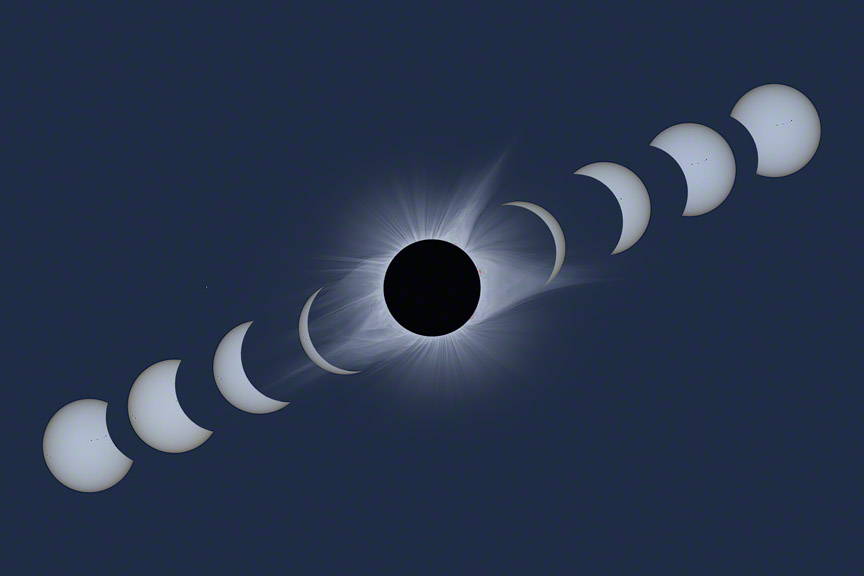
The solar corona as seen during the total solar eclipse of August 21, 2017, along with inset images of partial phases before (on the left) and after (on the right) totality. The image of totality was processed to approximate the detail visible through binoculars. The partial phases shown are approximately 20 minutes apart starting about 10 minutes on either side of totality.
Totality: Composite of 28 frames with exposure ranging from 1/2000 second to 4 seconds at ASA 100. Partial phases: 1/125 seconds at ASA 100 through a solar filter. All taken through an equatorially mounted Astro-Physics 105mm refractor at f6.2 using a Canon 5DIII from Silver Point, Tennessee. Frames of totality were corrected using an additional 225 flat field, dark, and bias frames. Coronal details were enhanced using HDR techniques. ©2017
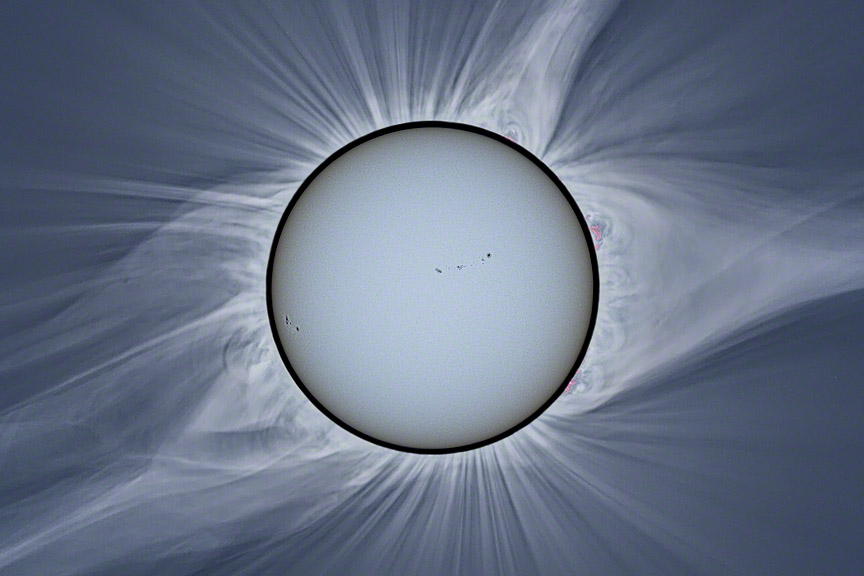
An image of the uneclipsed Sun shown overlaid on an image of corona during the total eclipse of 2017-08-09. The Moon is the black annulus seen behind the overlaid Sun and just inside the solar corona. This overlay shows the relative apparent size of the Sun and Moon. A total eclipse of the Sun occurred, in part, because the Moon's apparent size was a bit larger than the Sun's. You can see how much the apparent size of the Moon changes as it orbits the Earth here. A few groups of sunspots were visible on the surface of the Sun.
Corona: Composite of 28 frames with exposure ranging from 1/2000 second to 4 seconds at ASA 100. Sun: 1/125 seconds at ASA 100. Both through an Astro-Physics 105mm refractor at f6.2 using a Canon 5DIII from Silver Point, Tennessee on 2017-08-21. All frames of the corona were corrected using an additional 225 flat field, dark, and bias frames. Coronal details were enhanced using HDR techniques. ©2017
| |||||||||||||||||
|
Astrophotography Books – Astronomy Books |








